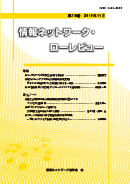Volume 19
Displaying 1-12 of 12 articles from this issue
- |<
- <
- 1
- >
- >|
ARTICLES
-
2020 Volume 19 Pages 1-15
Published: December 20, 2020
Released on J-STAGE: December 25, 2020
Download PDF (492K) -
2020 Volume 19 Pages 16-29
Published: December 20, 2020
Released on J-STAGE: December 25, 2020
Download PDF (437K) -
2020 Volume 19 Pages 30-46
Published: December 20, 2020
Released on J-STAGE: December 25, 2020
Download PDF (623K) -
2020 Volume 19 Pages 47-63
Published: December 20, 2020
Released on J-STAGE: December 25, 2020
Download PDF (958K) -
2020 Volume 19 Pages 64-80
Published: December 20, 2020
Released on J-STAGE: December 25, 2020
Download PDF (712K)
NOTES
-
2020 Volume 19 Pages 81-120
Published: December 20, 2020
Released on J-STAGE: December 25, 2020
Download PDF (7923K) -
2020 Volume 19 Pages 121-133
Published: December 20, 2020
Released on J-STAGE: December 25, 2020
Download PDF (503K) -
2020 Volume 19 Pages 134-152
Published: December 20, 2020
Released on J-STAGE: December 25, 2020
Download PDF (975K) -
2020 Volume 19 Pages 153-166
Published: December 20, 2020
Released on J-STAGE: December 25, 2020
Download PDF (569K) -
2020 Volume 19 Pages 167-183
Published: December 20, 2020
Released on J-STAGE: December 25, 2020
Download PDF (724K) -
2020 Volume 19 Pages 184-195
Published: December 20, 2020
Released on J-STAGE: December 25, 2020
Download PDF (473K) -
2020 Volume 19 Pages 196-210
Published: December 20, 2020
Released on J-STAGE: December 25, 2020
Download PDF (473K)
- |<
- <
- 1
- >
- >|
